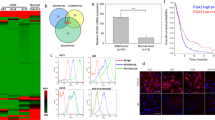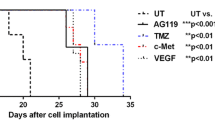Abstract
Human melanoma proteoglycan (HMP), a melanoma-associated antigen, is expressed in both human melanomas and gliomas. We used HMP-specific monoclonal antibody (mAb) VT68.2 to investigate whether murine GL261 cerebral gliomas express the HMP homologue AN2 and to determine whether AN2 could be targeted for selective delivery of radiation in vivo. HMP-specific mAb VT68.2 stained murine GL261 glioma cells grown in culture and intracerebrally in syngeneic C57BL/6 mice. Positron emission tomography with radiolabeled mAb VT68.2 showed high-contrast, positive images of gliomas against a negative background. At 96 h after injection, glioma uptake of radiolabeled mAb VT68.2 was 10× greater than that of the isotype control mAb and 20× greater than that detected in normal cerebral tissue. Our results show murine GL261 cerebral gliomas express AN2 and HMP-specific mAb VT68.2 accumulates selectively and specifically at high concentration and is retained within murine cerebral gliomas. Thus, HMP is a potential target for antibody-mediated selective delivery of radiation to cerebral gliomas in vivo.




Similar content being viewed by others
References
Stupp R, Hegi ME, Gilbert MR, Chakravarti A (2007) Chemoradiotherapy in malignant glioma: standard of care and future directions. J Clin Oncol 25:4127–4136. doi:10.1200/JCO.2007.11.8554
Fenstermaker RA, Ciesielski MJ (2004) Immunotherapeutic strategies for malignant glioma. Cancer Control 11:181–191
Kurpad SN, Zhao XG, Wikstrand CJ, Batra SK, McLendon RE, Bigner DD (1995) Tumor antigens in astrocytic gliomas. Glia 15:244–256. doi:10.1002/glia.440150306
Chai DD, Merchant RE, Rand R et al (1997) Molecular detection of tumor-associated antigens shared by human cutaneous melanomas and gliomas. Am J Pathol 150:2143–2152
Sasaki M, Nakahira K, Kawano Y et al (2001) MAGE-E1, a new member of the melanoma-associated antigen gene family and its expression in human glioma. Cancer Res 61:4809–4814
Prins RM, Odesa SK, Liau LM (2003) Immunotherapeutic targeting of shared melanoma-associated antigens in a murine glioma model. Cancer Res 63:8487–8491
Colapinto EV, Zalutsky MR, Archer GE et al (1990) Radioimmunotherapy of intracerebral human glioma xenografts with 131I-labeled F(ab′)2 fragments of monoclonal antibody Mel-14. Cancer Res 50:1822–1827
Schrappe M, Bumol TF, Apelgren LD et al (1992) Long-term growth suppression of human glioma xenografts by chemoimmunoconjugates of 4-desacetylvinblastine-3-carboxyhydrazide and monoclonal antibody 9.2.27. Cancer Res 52:3838–3844
Hjortland GO, Garman-Vik SS, Juell S et al (2004) Immunotoxin treatment targeted to the high-molecular-weight melanoma-associated antigen prolonging the survival of immunodeficient rats with invasive intracranial human glioblastoma multiforme. J Neurosurg 100:320–327
Campoli MR, Chang CC, Kageshita T, Wang X, McCarthy JB, Ferrone S (2004) Human high molecular weight-melanoma-associated antigen (HMP): a melanoma cell surface chondroitin sulfate proteoglycan (MSCP) with biological and clinical significance. Crit Rev Immunol 24:267–296. doi:10.1615/CritRevImmunol.v24.i4.40
Schrappe M, Klier FG, Spiro RC, Waltz TA, Reisfeld RA, Gladson CL (1991) Correlation of chondroitin sulfate proteoglycan expression on proliferating brain capillary endothelial cells with the malignant phenotype of astroglial cells. Cancer Res 51:4986–4993
Shoshan Y, Nishiyama A, Chang A et al (1999) Expression of oligodendrocyte progenitor cell antigens by gliomas: implications for the histogenesis of brain tumors. Proc Natl Acad Sci USA 96:10361–10366. doi:10.1073/pnas.96.18.10361
Chekenya M, Rooprai HK, Davies D, Levine JM, Butt AM, Pilkington GJ (1999) The NG2 chondroitin sulfate proteoglycan: role in malignant progression of human brain tumours. Int J Dev Neurosci 17:421–435. doi:10.1016/S0736-5748(99)00019-2
Chekenya M, Enger PO, Thorsen F et al (2002) The glial precursor proteoglycan, NG2, is expressed on tumour neovasculature by vascular pericytes in human malignant brain tumours. Neuropathol Appl Neurobiol 28:367–380. doi:10.1046/j.1365-2990.2002.00412.x
Pluschke G, Vanek M, Evans A et al (1996) Molecular cloning of a human melanoma-associated chondroitin sulfate proteoglycan. Proc Natl Acad Sci USA 93:9710–9715. doi:10.1073/pnas.93.18.9710
Nishiyama A, Dahlin KJ, Prince JT, Johnstone SR, Stallcup WB (1991) The primary structure of NG2, a novel membrane-spanning proteoglycan. J Cell Biol 114:359–371. doi:10.1083/jcb.114.2.359
Stegmuller J, Schneider S, Hellwig A, Garwood J, Trotter J (2002) AN2, the murine homologue of NG2, is a surface antigen on glial precursor cells implicated in control of cell migration. J Neurocytol 31:497–505. doi:10.1023/A:1025743731306
Chekenya M, Hjelstuen M, Enger PO et al (2002) NG2 proteoglycan promotes angiogenesis-dependent tumor growth in CNS by sequestering angiostatin. FASEB J 16:586–588
Chekenya M, Immervoll H (2007) NG2/HMP proteoglycan as a cancer therapeutic target. Methods Mol Biol 361:93–117
Temponi M, Gold AM, Ferrone S (1992) Binding parameters and idiotypic profile of the whole immunoglobulin and Fab′ fragments of murine monoclonal antibody to distinct determinants of the human high molecular weight-melanoma associated antigen. Cancer Res 52:2497–2503
Kusama M, Kageshita T, Chen ZJ, Ferrone S (1989) Characterization of syngeneic antiidiotypic monoclonal antibodies to murine antihuman high molecular weight-melanoma associated antigen monoclonal antibodies. J Immunol 143:3844–3852
Ghose T, Ferrone S, Blair AH et al (1991) Regression of human melanoma xenografts in nude mice injected with methotrexate linked to monoclonal antibody 225.28 to human high molecular weight-melanoma associated antigen. Cancer Immunol Immunother 34:90–96. doi:10.1007/BF01741341
Siccardi AG, Buraggi GL, Callegaro L et al (1986) Multicenter study of immunoscintigraphy with radiolabeled monoclonal antibodies in patients with melanoma. Cancer Res 46:4817–4822
Szatmari T, Lumniczky K, Desaknai S et al (2006) Detailed characterization of the murine glioma 261 tumor model for experimental glioblastoma therapy. Cancer Sci 97:546–553. doi:10.1111/j.1349-7006.2006.00208.x
Candolfi M, Curtin JF, Nichols WS et al (2007) Intracranial glioblastoma models in preclinical neuro-oncology: neuropathological characterization and tumor progression. J Neurooncol 85:133–148. doi:10.1007/s11060-007-9400-9
Cha S, Johnson G, Wadghiri YZ et al (2003) Dynamic, contrast-enhanced perfusion MRI in mouse gliomas: correlation with histopathology. Magn Reson Med 49:848–855. doi:10.1002/mrm.10446
Temponi M, Kageshita T, Perosa F, Ono R, Okada H, Ferrone S (1989) Purification of murine IgG monoclonal antibodies by precipitation with caprylic acid: comparison with other methods of purification. Hybridoma 8:85–95
Sajjad M, Bars E, Nabi HA (2006) Optimization of 124I production via 124Te(p, n)124I reaction. Appl Radiat Isot 64:965–970. doi:10.1016/j.apradiso.2006.04.004
Vaidyanathan G, Zalutsky MR (1990) Radioiodination of antibodies via N-succinimidyl 2,4-dimethoxy-3-(trialkylstannyl)benzoates. Bioconjug Chem 1:387–393. doi:10.1021/bc00006a004
Lindmo T, Boven E, Cuttitta F, Fedorko J, Bunn PA Jr (1984) Determination of the immunoreactive fraction of radiolabeled monoclonal antibodies by linear extrapolation to binding at infinite antigen excess. J Immunol Methods 72:77–89. doi:10.1016/0022-1759(84)90435-6
Kim JS, Lee JS, Im KC et al (2007) Performance measurement of the microPET focus 120 scanner. J Nucl Med 48:1527–1535. doi:10.2967/jnumed.107.040550
Moshakis V, McIlhinney R, Raghavan D, Neville AM (1981) Monoclonal antibodies to detect human tumours: an experimental approach. J Clin Pathol 34:314–319. doi:10.1136/jcp.34.3.314
Jones TR, Ruoslahti E, Schold SC, Bigner DD (1982) Fibronectin and glial fibrillary acidic protein expression in normal human brain and anaplastic human gliomas. Cancer Res 42:168–177
Dawson MR, Polito A, Levine JM, Reynolds R (2003) NG2-expressing glial progenitor cells: an abundant and widespread population of cycling cells in the adult rat CNS. Mol Cell Neurosci 24:476–488. doi:10.1016/S1044-7431(03)00210-0
Stallcup WB, Beasley L (1987) Bipotential glial precursor cells of the optic nerve express the NG2 proteoglycan. J Neurosci 7:2737–2744
Reardon DA, Akabani G, Coleman RE et al (2006) Salvage radioimmunotherapy with murine iodine-131-labeled antitenascin monoclonal antibody 81C6 for patients with recurrent primary and metastatic malignant brain tumors: phase II study results. J Clin Oncol 24:115–122. doi:10.1200/JCO.2005.03.4082
Quang TS, Brady LW (2004) Radioimmunotherapy as a novel treatment regimen: 125I-labeled monoclonal antibody 425 in the treatment of high-grade brain gliomas. Int J Radiat Oncol Biol Phys 58:972–975. doi:10.1016/j.ijrobp.2003.09.096
Riva P, Arista A, Sturiale C et al (1992) Treatment of intracranial human glioblastoma by direct intratumoral administration of 131I-labelled anti-tenascin monoclonal antibody BC-2. Int J Cancer 51:7–13. doi:10.1002/ijc.2910510103
Yuan H, Gaber MW, Boyd K, Wilson CM, Kiani MF, Merchant TE (2006) Effects of fractionated radiation on the brain vasculature in a murine model: blood-brain barrier permeability, astrocyte proliferation, and ultrastructural changes. Int J Radiat Oncol Biol Phys 66:860–866. doi:10.1016/j.ijrobp.2006.06.043
Petronzelli F, Pelliccia A, Anastasi AM et al (2005) Improved tumor targeting by combined use of two antitenascin antibodies. Clin Cancer Res 11:7137s–7145s. doi:10.1158/1078-0432.CCR-1004-0007
Grana C, Chinol M, Robertson C et al (2002) Pretargeted adjuvant radioimmunotherapy with yttrium-90-biotin in malignant glioma patients: a pilot study. Br J Cancer 86:207–212. doi:10.1038/sj.bjc.6600047
Sundaresan G, Yazaki PJ, Shively JE et al (2003) 124I-labeled engineered anti-CEA minibodies and diabodies allow high-contrast, antigen-specific small-animal PET imaging of xenografts in athymic mice. J Nucl Med 44:1962–1969
Acknowledgements
This work was supported in part by research grants NS049309 awarded to RAF by the National Institute of Neurological Disorders and Stroke (NIH/NINDS) and CA105500 awarded to SF by the National Cancer Institute. Additional support provided by the Roswell Park Cancer Institute Cancer Center Support Grant CA16056-29 (NIH-NCI), the Roswell Park Alliance Foundation and the Linda Scime Neurosurgery Endowment Fund. The authors would like to thank Rolf F. Barth, MD for his generous gift of GL261 glioma cells and John Luisi, CNMT for the assistance with microPET data acquisition.
Author information
Authors and Affiliations
Corresponding author
Rights and permissions
About this article
Cite this article
Paul, A.K., Ciesielski, M.J., Sajjad, M. et al. Expression of HMP/AN2, a melanoma associated antigen, in murine cerebral gliomas: potential for radioimmunotargeting. J Neurooncol 94, 21–30 (2009). https://doi.org/10.1007/s11060-009-9798-3
Received:
Accepted:
Published:
Issue Date:
DOI: https://doi.org/10.1007/s11060-009-9798-3




